Wolf's Head, The Cirque of the Towers
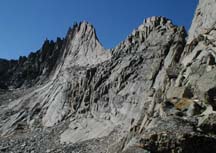
The left summit is Wolf's Head, the right one is Tiger
Tower.
Wolf's Head, The Cirque of the Towers

The left summit is Wolf's Head, the right one is Tiger
Tower.
I have always wanted to climb Wolf's head, but many of my partners had already done it. For example, Martin and Morresa had lead Cindy and Al up Wolf's head many years ago. It was an epic climb and they spent the night on the mountain. Lucky for me they were willing to go back and climb it again. This time we planned to climb fast and finish it in a day.
We backpacked from the Big Sandy trailhead in to the Cirque of the Towers. Easy to say, harder to do. We were carrying climbing gear that boosted our packs to 50 pounds each. Thank goodness from Big Sandy in to the Cirque the scenery just gets better and better.
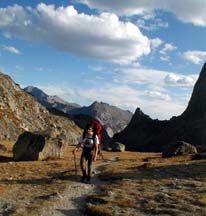
The next morning at our usual 5:30 AM we got up, made breakfast and then hit the trail just as it got light at 6:30 AM. Martin wanted me to experience the entire climb so we stopped below the gully that separates Pingora from Tiger Tower. Here we changed into our climbing shoes and harnesses and cached our hiking boots. We climbed up to the Tiger Tower-Pingora col without breaking out the rope. There was some interesting climbing along the way. At the col Martin suggested we take a variation that goes right up the crest of the ridge so we put on the rope and lead off. (I noted an easier variation on the south face that seemed to go without a rope.) But Martin's route sure was fun. We swung leads fast taking 15 to 20 minutes a pitch for the three of us. We ended up by doing two short rappels into the notch between Tiger Tower and Wolf's Head.
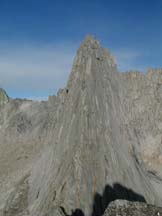
From the notch below Wolf's Head you get an incredible view of the 3 pitches of narrow ridge ahead. Martin graciously gave me the lead of the first pitch which goes along a meter-wide knife-edge ridge with big air on both sides. A classic pitch if there ever was one.
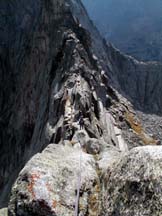
We moved fast, I would lead a pitch, Morresa would follow and rebuild the rack while Martin climbed. When Martin arrived she would hand him the rack and off he'd go. Fun, fast, efficient climbing possible with a team that has been climbing together for over 20 years. Martin lead the next steeper narrow pitch.
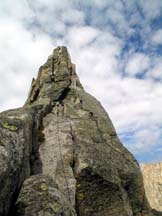
The weather had been clear all morning. Now in the course of one pitch it got bad fast. As you can see from the above photo clouds began to cover the sky. I was amazed at ow fast they moved in and quickly they thickened into a dark mass. The temperature plummeted and the wind started to blow. Later on we found that the jet stream was blowing straight over us pushing a cold front down from Canada. By the time we joined Martin at the belay I suggested that we think about retreating. I knew that ahead of us we had a lot of pitches and that retreat was difficult. Martin paused a moment to think over my idea. It began to sleet. He quickly agreed that it was time to go down.
We downclimbed to Tiger Tower-Wolf's Head Col. We knew that a third-class climb reached this point. We climbed down to a large ledge and while searching for the descent climb I found a set of rappel slings at the west end of the ledge. We did three double rope rappels down the face to the ground. We rappelled down an impressive cliff of granite. Given the line of the rappel I wondered if it started at the top of the first summit of Wolf's Head. That would be good to know about in case of future retreats.
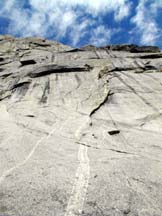
As we retreated the weather improved. The clouds began to break up and the sun came out. But it stayed cold and windy. We agonized over whether we had made the right choice to retreat. However a half-hour later a second wave of clouds and sleet moved in confirming the correctness of our decision. This was the pattern all day long as waves of sleet and rain alternated with sunny cold wind.
Over on Pingora we saw several other groups continuing to climb.
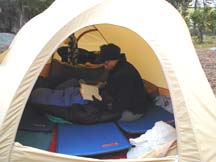
Late afternoon a wall of wind blasted our tent and the world around us. There were three teams high on the classic route on Pingora. When the wind hit them one party pulled out a red tarp and sheltered under it. They had a couple of pitches to go. At this point we wondered if we were going to have to rescue anyone. But this wave of bad weather also came to an end and allowed all the parties to reach the summit shortly after sunset. As the sky got darker we could see them rappelling and expected that they would reach their tents without difficulty. We were wrong.
The seven people from three groups had joined together to speed the rappels. They made it down to the south shoulder ridge of Pingora. But on the way down the ridge night fell and they found themselves facing a long descent down an icy sloping ridge. While the oldest experienced climber urged them to rappel down so that they could reach their tents, the rest of the group mutinied and sheltered in shallow caves. During the night there was a lightning storm, and shallow caves are not the place to be during lightning strikes. But they all survived the cold windy stormy night and returned to their camps after daylight. Alive, but dead tired.
In the morning, during breakfast, another wave of sleet poured down on our camp. This inspired Martin and I to tune in to the weather radio. What it said chilled our bones. A colder airmass was coming, with temperatures dropping into the teens accompanied by wind and significant accumulations of snow. We looked at each other and together said, "Let's get out of here." We packed up our gear and headed out to Salt Lake City to climb in the warm environs of Little Cottonwood Canyon and Big Cottonwood Canyon.
We made the right choice.
|
Scientific Explorations with Paul Doherty |
|
21 Sep 2001 |